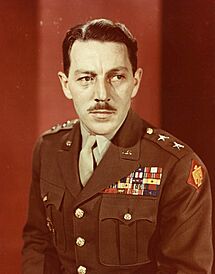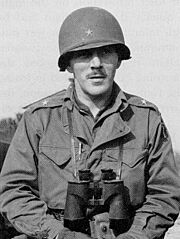Robert T. Frederick facts for kids
Quick facts for kids
Robert T. Frederick
|
|
|---|---|
 |
|
| Born | March 14, 1907 San Francisco, California, U.S. |
| Died | November 29, 1970 (aged 63) Stanford, California, U.S. |
| Allegiance | United States |
| Service/ |
United States Army |
| Years of service | 1928–1952 |
| Rank | Major General |
| Service number | O-17196 |
| Unit | Coastal Artillery Corps |
| Commands held | 1st Special Service Force 1st Allied Airborne Task Force 45th Infantry Division 4th Infantry Division 6th Infantry Division |
| Battles/wars | World War II |
| Awards | Distinguished Service Cross (2) Army Distinguished Service Medal (2) Silver Star Legion of Merit (2) Bronze Star Medal (2) Purple Heart (8) |
Major General Robert Tryon Frederick (March 14, 1907 – November 29, 1970) was a senior United States Army officer. During World War II, he commanded the 1st Special Service Force, the 1st Allied Airborne Task Force, and the 45th Infantry Division, and was twice awarded the Distinguished Service Cross.
Contents
Early life and military career
Frederick was born on March 14, 1907, in San Francisco, California. He attended Staunton Military Academy from 1923 to 1924 and the United States Military Academy (USMA) at West Point from 1924 to 1928. Upon graduation from West Point, New York, he was commissioned as a second lieutenant in the Coast Artillery Corps of the United States Army. He graduated from the U.S. Army Command and General Staff College at Fort Leavenworth, Kansas in 1939.
World War II
Frederick was serving as a staff officer in the War Department when the United States entered World War II following to the Japanese attack on Pearl Harbor. In 1942 Frederick, then a lieutenant colonel, was tasked with raising a new U.S.-Canadian regiment size commando force, which became the 1st Special Service Force (later called the "Devil's Brigade" by the Germans). The unit, activated on July 9, 1942, at Fort William Henry Harrison, Montana, was originally intended for commando operations in Norway, and trained extensively in winter and mountain warfare, as well as hand-to-hand combat and other infantry skills. In April 1943, the unit moved to Camp Bradford, Virginia for training, then to Fort Ethan Allen, Vermont. The Norway mission was cancelled, however, and the 1st Special Service Force was sent instead to the Aleutian Islands in July 1943. It returned to the contiguous United States in September, and then left in October for the European Theater of Operations (ETO).
Frederick's men arrived in Casablanca in French Morocco in November 1943 and quickly moved to the Italian front. Landing at Naples on November 19, 1943, the 1st Special Service Force went into the line. In December 1943 and January 1944, the 1st Special Service Force conducted a series of operations at Monte la Difensa, Monte la Remetanea, Monte Sammucro (Hill 720) and Monte Vischiataro. The 1st Special Service Force attacked and captured the enemy forces at the impregnable Monte la Difensa.
On February 2, 1944, Frederick, now a full colonel, and his men landed at Anzio and went into action along the Mussolini Canal. They were the first Allied troops to enter the Italian capital of Rome on June 4, 1944. Frederick was decorated twice with the Distinguished Service Cross, the U.S. Army's second highest award for valor in combat. The first award was for actions on January 10–13, 1944 at Monte Majo where Frederick was wounded three times in combat, and the second award for actions on June 4, 1944 during the drive on Rome. While at Anzio he was wounded a number of times, including two separate wounds on a single day.
On June 23, 1944, Frederick announced he was leaving the unit. He was promoted to the one-star general officer rank of brigadier general in July, and was given command of the 1st Allied Airborne Task Force, an ad hoc division-sized airborne formation, for the Allied invasion of Southern France. The task force consisted of the British 2nd Independent Parachute Brigade and the American 509th and 551st Parachute Infantry Battalions, the 517th Parachute Regimental Combat Team, the 550th Glider Infantry Battalion, and the 460th and 463rd Parachute Field Artillery Battalions, along with various support units.
On August 15, under the code name Rugby Force, the unit jumped into the Argens Valley between Le Luc and Le Muy, behind the Massif des Maures, a key piece of terrain which overlooked the Allied landing beaches near St. Tropez and St. Raphaël. Having successfully blocked German forces from reaching the invasion beaches, the 1st Airborne Task Force linked up with the U.S. 36th Infantry Division on August 17, 1944. It then moved up the French Riviera coastline, taking Cannes unopposed on August 24, 1944, and linking up with Frederick's old unit, the 1st Special Service Force. The 1st Special Service Force had initially been tasked to seize several small islands off the French Riviera and then moved onshore, where it was attached to the 1st Airborne Task Force on August 22 (replacing the British 2nd Independent Parachute Brigade). The task force then fought on to the French-Italian border, where it took up defensive positions. The task force was dissolved on November 23, 1944 (and the 1st Special Service Force was disbanded on December 5).
Frederick was, at the age of just 37, promoted to the two-star rank of major general and given command of the 45th Infantry Division on December 3, 1944. Along with Major General James M. Gavin, then commanding the 82nd Airborne Division, this made both Frederick and Gavin (eight days younger than Frederick) the two youngest division commanders in the U.S. Army during the war. He led the 45th Division until September 10, 1945. The 45th saw heavy combat in French Alsace from December 1944 through to February 1945, and was pulled from the line to rehabilitate on February 17. In mid-March, it was assigned to XV Corps for Operation Undertone, the final drive into Germany.
The division crossed the Rhine and advanced to the Main. Moving along the Main into Bavaria, participating in heavy fighting in Aschaffenburg from March 28 to April 3 and then drove to Nuremberg, taken in heavy fighting from April 16–20. Moving south, the division crossed the Danube on April 26, and opened up the path for the U.S. 20th Armored Division to drive on Munich. Reaching Munich on April 29, the division shifted from combat to occupation.
The British Prime Minister, Sir Winston Churchill, declared that Frederick was "the greatest fighting general of all time" and "if we had had a dozen more like him we would have smashed Hitler in 1942".
Post-World War II
After a period of occupation duty, the 45th Infantry Division prepared to return to the United States and Frederick relinquished command in September 1945. From 1 November 1945 to 19 August 1947 he was commandant of the Coast Artillery School, and presided over its move from Fort Monroe to Fort Winfield Scott. After a period of staff duty and recuperation (he had been wounded eight times), Major General Frederick was assigned to Allied occupation forces in Austria, commanding the U.S. Sector, of the Vienna Inter-Allied Command in 1948. From February 28, 1949, to October 10, 1950, he commanded the 4th Infantry Division, which had been reactivated as a training division at Fort Ord, California, in 1947. In October 1950, the division was redesignated the 6th Infantry Division, and Frederick continued as its commanding general until 1951.
In 1951, Frederick returned to Europe to take command of the Joint U.S. Military Aid Group, Greece (JUSMAG Greece). He retired on disability in March 1952. In the 1968 film The Devil's Brigade, which chronicled the formation, training and combat in Italy of the 1st Special Service Force, Robert T. Frederick was played by actor William Holden. Frederick died on November 29, 1970, in Stanford, California.
V-42 combat knife
The V-42 combat knife was designed in part by Frederick when commanding officer of the 1st Special Service Force. The V-42 was the trademark weapon of the 1st Special Service Force, and its members were trained extensively in its use. It is a short-bladed stiletto with a thumb groove on the top of the blade to promote proper hand placement when attacking an opponent. It is often confused with the longer- and thicker-bladed Fairbairn–Sykes fighting knife. The profile of the V-42 knife appears in the crests of the U.S. Army Special Forces and Canada's Joint Task Force Two.
Military awards
Frederick's military decorations and awards include:
|
|
|||
| 1st Row | Distinguished Service Cross w/ Oak Leaf Cluster | Army Distinguished Service Medal w/ Oak Leaf Cluster | Silver Star | |||||||||||||||
|---|---|---|---|---|---|---|---|---|---|---|---|---|---|---|---|---|---|---|
| 2nd Row | Legion of Merit w/ Oak Leaf Cluster | Bronze Star Medal w/ Oak Leaf Cluster | Air Medal | Purple Heart w/ seven Oak Leaf Clusters | ||||||||||||||
| 3rd Row | American Defense Service Medal w/ battle clasp (service star) | American Campaign Medal | Asiatic-Pacific Campaign Medal w/ one service star and Arrowhead device | European-African-Middle Eastern Campaign Medal w/ three service stars | ||||||||||||||
| 4th Row | World War II Victory Medal | Army of Occupation Medal | National Defense Service Medal | Distinguished Service Order (United Kingdom) | ||||||||||||||
| 5th Row | Officer of the Legion of Honour (France) | Croix de guerre 1939–1945 w/ palm (France) | Grand Officer of the Order of St. Charles (Monaco) | King Haakon VII Freedom Medal (Norway) | ||||||||||||||



